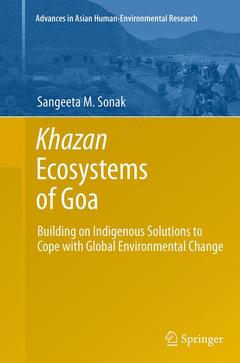Description
Khazan Ecosystems of Goa, 2014
Building on Indigenous Solutions to Cope with Global Environmental Change
Advances in Asian Human-Environmental Research Series
Author: Sonak Sangeeta M.
Language: English
Subjects for Khazan Ecosystems of Goa:
Publication date: 08-2016
Support: Print on demand
Approximative price 105.49 €
In Print (Delivery period: 15 days).
Add to cartPublication date: 10-2013
137 p. · 15.5x23.5 cm · Hardback
Description
/li>Contents
/li>Biography
/li>Comment
/li>
This book elaborates on the Khazan ecosystems of Goa, India. Khazans are human-managed ecosystems, which are reclaimed from coastal wetlands, salt marshes and mangrove areas, where tidal influence is regulated through a highly structured system of dykes, canals, furrows, and sluice gates using resources that are amply available locally. Khazan ecosystems are marvels of tribal engineering. They are a simple architectural design, which operate at a very low running cost using tidal, hydro, and solar energy. The design contributes to a highly complex but eco-friendly ecosystem integrating agriculture, aquaculture and salt panning. . Khazan ecosystems have been functional for the last 3500 years. The history of Khazans is very ancient and can be traced to the transition from food gathering to food growing, which has been regarded as the biggest step in the history of human civilization. Khazan ecosystems thus have a high historical and world heritage value. They are also repositories of global biodiversity, with unique flora suitable to their unique and highly variable environment. They are endemic and heritage ecosystems of Goa and ultimately reservoirs of history and heritage.
Using the example of the Khazan lands, the book analyzes and comments on traditional ecological knowledge and indigenous technology. It presents the evolution of Khazan management institutions over a period of more than three thousand years, as well as factors that have contributed to its decline in recent years. It develops a conceptual framework for ecosystem performance and suggests strategies for conservation of Khazans as well as strategies to build on these indigenous adaptation mechanisms to cope with the global environmental change.
Indigenous traditional knowledge and Global Environmental Change.- An introduction to Goa and Khazan ecosystems.- Traditional ecological knowledge and environmental sustainability in Khazan.- Management of khazan ecosystems: contested environments, competing interests and changing institutions.- Erosion of indigenous resource base: causes and challenges.- A framework for ecosystem performance, ecological vulnerability, ecosystem valuation and local livelihoods using Khazan example.- Building on indigenous resource management systems: key to finding solutions.
Sangeeta Sonak is the Director of the Centre for Environment and Natural Resource Management, Srujan in Panaji, India and a marine biologist with more than twenty years of research experience. Her major focus is on natural resource management aspects, particularly coastal and marine research management. She has co-ordinated and guided several research projects funded by national and international funding agencies, and her areas of interest include human environment interactions, environment management institutions, policy analysis and community based resource management. She has published several articles in international journals, edited two books and a journal special issue, and has been awarded prestigious international fellowships such as a Fulbright Scholarship under Fulbright-Nehru Environmental leadership program (FNELP) at Virginia Tech Institute, USA; a JSPS Fellowship for Senior Scientists by the Japanese Society for the Promotion of Science (JSPS), and an Erasmus Mundus Fellowship for Visiting Scientists to teach and conduct research at three European universities by the European Commission.




